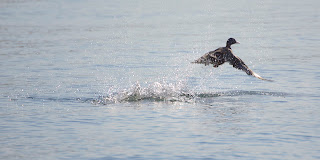
Generally, once a week, light conditions permitting, I put 5-6 hrs into my current portrait project. This is the progress stage I am at with a friend's boyfriend's portrait. I work in natural window light so it needs to be an overcast type day so I don't get annoying bright strips of light across my work area, but nice diffused light to paint in. Bright light makes me crazy to begin with so I find working under anything but diffused natural light, grating on my nerves.
I am spending time solving the values in the face first, with colour being a secondary concern once values in areas are right. I tend to do this in a back and forth way. This can result in too many layers being built before areas are solved, but 9 times out of 10 it works for me. If I reach a point where the only choice is to sand back some of the surface, it often means the portrait is doomed. Luckily, it rarely happens but it has once in a while. Depending on how much damage control needs to be done, determines whether I can continue painting on the surface, or if gawd forbid, I need to discard and begin anew. I have had to begin anew maybe 3 times in the past 20 years. It's not fun.
Here, I have still the areas above the lip, and the lip still to solve, a lot of the major areas on the forehead and back onto the crown, as well as the chin - all needing the majority of the work. The eye areas, neck, the cheeks and towards the ear need less work.
Alternating into the background and clothing, simultaneously with the skin tones, needs to happen as well, to keep values balanced and easier to determine the accuracy of. Most likely, i will begin into the top and folded arms soon, and as well continue to build the background. Going back and forth with background and edges of the figure, especially the ones farthest from the viewer's eye, helps keep that "figure cut out and pasted in a background" look from occurring. I frigging hate that look in portraits and figure paintings and I try hard to avoid it in my work.
Palette
titanium white
naples yellow
yellow ochre
raw sienna
burnt sienna
cadmium red light
naphthol red medium - Golden
ultramarine blue (red)
cobalt blue
chormium oxide green - Golden
I use Liquitex heavy body tube acrylics (other than the couple Goldens noted), and I use a fluid medium, not a lot of water but do have it out for use when needed. My palette is a white ceramic dinner plate. I use paper towel to dab my brush on. My brush generally is a synthetic round and a chisel. I do have a large flat brush for background lay in. I begin on a toned canvas, either cool or warm depending on the portrait itself.
My method to begin is a draw on, freehand, with a charcoal pencil or soft pencil - 4b or more and sometimes a 2b for detail. I then dab off the excess with a soft eraser.
My method tends to be a dry brush small stroke build up of layer over layer. Acrylic suits my working method as the paint is not overly wet and softly rubs pigmet onto the texture of the canvas well, for soft blending. On hardboard, I use more of a thin glazing method, with slightly damper pigment. I never load much on a brush. My finished surfaces are not textured or raised very much, if at all.
 Lately, have been getting familiar with areas of MS Office Suite that I've not really had any opportunity to touch. One being Publisher. Not quite as great as InDesign but is actually a very useful program for small businesses or personal use for any number of creative project needs. I began with a template that I liked and altered the elements such as fonts, spacing, objects, photos, etc. and went with a theme from our major leisure undertaking, nature hikes. The intent behind this was to play around and practice using Publisher, using a personal theme to do so.
Lately, have been getting familiar with areas of MS Office Suite that I've not really had any opportunity to touch. One being Publisher. Not quite as great as InDesign but is actually a very useful program for small businesses or personal use for any number of creative project needs. I began with a template that I liked and altered the elements such as fonts, spacing, objects, photos, etc. and went with a theme from our major leisure undertaking, nature hikes. The intent behind this was to play around and practice using Publisher, using a personal theme to do so.
















































